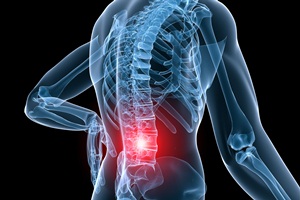Slipped Disc
What is a “Slipped Disc”?
 A slipped disc is the common term for a prolapsed or herniated spinal disc. These discs are set in position between the vertebrae and do not “slip”. Instead, the disc’s outer, fibrous ring tears, thereby allowing the soft, inner portion to extrude through the tear and press against the spinal nerves. Inflammatory chemicals may also be released as a result of the tear and may cause significant, long-term pain.
A slipped disc is the common term for a prolapsed or herniated spinal disc. These discs are set in position between the vertebrae and do not “slip”. Instead, the disc’s outer, fibrous ring tears, thereby allowing the soft, inner portion to extrude through the tear and press against the spinal nerves. Inflammatory chemicals may also be released as a result of the tear and may cause significant, long-term pain.
Depending on the location of the slipped disc, the individual may experience numbness and tingling sensations in the extremities, sciatica and even erectile dysfunction, in addition to the localized pain.
Diagnosis can be performed using a number of methods (X-rays, computed tomography, discography), but a magnetic resonance imaging scan (MRI) is usually the most effective, as it can provide highly detailed three-dimensional images of the affected area. These methods, however, are generally reserved for those cases where natural recovery has failed to improve the symptoms.
A physical examination is commonly performed prior to imaging tests and can include the testing of reflexes, sensations and muscle strength in the extremities and the patient’s ability to walk. These tests may include the straight-leg raising test where the patient slowly raises each of his or her legs individually while lying down. A slipped disc usually induces pain and/or numbness in patients as they raise their legs beyond two-thirds of their normal range.
Treatment in our office may include Muscle stimulator, Low Level Laser Therapy for Pain, Felxtion distraction, Axial Decompression, Therapeutic Exercises,and our chiropractor may also perform spinal adjustments to correct the subluxations that are causing the herniated disc.
Lifting, reaching and sitting for long periods of time during recovery are to be avoided as they often aggravate the condition. However, exercise is important since movement encourages blood flow to the affected area.Swimming is one of the best methods for exercising during recovery because it releases the compression forces on the spine while promoting blood flow, thereby encouraging the torn disc to repair itself.
Natural recovery can usually be achieved within 4 to 6 weeks, but if the symptoms persist past this point then the imaging tests (i.e., MRI) mentioned above can be applied. Depending on the severity of the tear, our Doctor may recommend surgery. Approximately 1 in 10 cases of herniated discs will require surgery due to severe nerve compression, difficulty in walking and standing, symptom severity and/or lack of improvement.
Surgery may consist of open discectomy (where all or a portion of the disc is removed), prosthetic disc replacement (where an artificial disc is inserted to replace the damaged disc), or endoscopic laser discectomy (where the compressed nerve causing the pain is released and part of the disc is removed using a laser and endoscope). Recovery from this type of surgery usually takes 2 to 6 weeks although in some cases, further surgery may be necessary.
As with most conditions, an ounce of prevention is worth a pound of cure. Regular visits to our chiropractic office can help nip any subluxation in the bud so that it does not lead to a slipped disc. Engage in regular exercise, avoid sitting for prolonged periods of time, maintain good posture, lift using the proper technique and drink plenty of water (so your discs stay well-hydrated). If you look after your general health and fitness, you will significantly reduce the likelihood of a slipped disc. If you or any one who you may know suffer for disc problem we can help the at Walk In Chiropractic clinic, You don’t need an appointment Just Walk-In.

